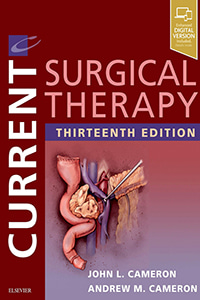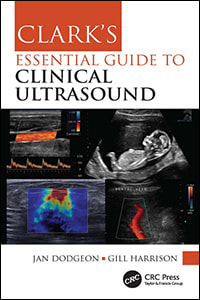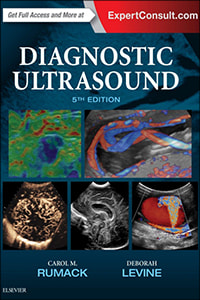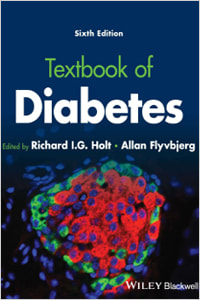An ideal resource for written, oral, and recertifying board study, as well as an excellent reference for everyday clinical practice, Current Surgical Therapy, 13th Edition, provides trusted, authoritative advice on today’s best treatment and management options for general surgery.
Contents
Overview
Residents and practitioners alike appreciate the consistent, highly formatted approach to each topic, as well as the practical, hands-on advice on selecting and implementing current surgical approaches from today’s preeminent general surgeons.
Features of Current Surgical Therapy 13th Edition:
- Provides thoroughly updated information throughout all 263 chapters, including focused revisions to the most in-demand topics such as management of rectal cancer, inguinal hernia, and colon cancer.
- Presents each topic using the same easy-to-follow format: disease presentation, pathophysiology, diagnostics, and surgical therapy.
- Includes seven all-new chapters: REBOA in Resuscitation of the Trauma Patient, Treatment of Varicose Veins, Management of Infected Grafts, Radiation for Pancreatic Malignancies, Pneumatosis Intestinalis, Proper Use of Cholecystostomy Tubes, and Pelvic Fractures.
- Integrates all minimally invasive surgical techniques into relevant chapters where they are now standard management.
- Discusses which approach to take, how to avoid or minimize complications, and what outcomes to expect.
- Features full-color images throughout, helping you visualize key steps in each procedure.
- Helps you achieve better outcomes and ensure faster recovery times for your patients.
- Provides a quick, efficient review prior to surgery and when preparing for surgical boards and ABSITEs.
Explore more books:
Book Details – Current Surgical Therapy 13th Edition
Book Details

- Title: Current Surgical Therapy 13th Edition
- Author: Andrew M. Cameron John L. Cameron
- Publisher: Elsevier
- Publication: 2020
- Edition: 13th Ed
- Language: English
- Book Format: PDF
- Book Series: Current Series
Table of contents
- Contributors……Page 4
- Preface……Page 31
- 1 – Esophageal FunctionTests……Page 32
- 2 – Surgical Management of Gastroesophageal Reflux Disease……Page 40
- 3 – Magnetic Augmentationof the LowerEsophageal Sphincter……Page 48
- 4 – Management ofBarrett’s Esophagus……Page 53
- 5 – Endoscopic Treatmentof Barrett’s Esophagus……Page 60
- 6 – Management of Paraesophageal Hiatal Hernia……Page 66
- 7 – Management of Zenker’s Diverticulum……Page 71
- 8 – Achalasia of the Esophagus……Page 75
- 9 – Management of Disorders of Esophageal Motility……Page 82
- 10 – Management of Esophageal Cancer……Page 91
- 11 – Multimodality Therapyin Esophageal Cancer……Page 102
- 12 – Use of Esophageal Stents……Page 110
- 13 – Management of Esophageal Perforation……Page 119
- 14 – Benign Gastric Ulcer……Page 122
- 15 – Management of Duodenal Ulcers……Page 127
- 16 – Management of Zollinger-Ellison Syndrome……Page 131
- 17 – Management of Mallory-Weiss Syndrome……Page 137
- 18 – Management of Gastric Adenocarcinoma……Page 142
- 19 – Familial Gastric Cancer……Page 148
- 20 – Management of Gastrointestinal Stromal Tumors……Page 155
- 21 – Management of Morbid Obesity……Page 162
- 22 – Management of Small Bowel Obstruction……Page 167
- 23 – Management of Crohn’s Disease of the Small Bowel……Page 174
- 24 – Use of Strictureplasty in Crohn’s Disease……Page 178
- 25 – Management of Small Bowel Tumors……Page 184
- 26 – Management of Diverticulosis of the Small Bowel……Page 190
- 27 – Management of Motility Disorders of the Stomach and Small Bowel……Page 193
- 28 – Management of Intestinal Failure……Page 200
- 29 – Management of Enterocutaneous Fistulas……Page 206
- 30 – Preoperative Bowel Preparation: Is It Necessary?……Page 211
- 31 – Management of Diverticular Disease of the Colon……Page 215
- 32- Management of Chronic Ulcerative Colitis……Page 222
- 33 – Management of Toxic Megacolon……Page 230
- 34 – Management of Crohn’s Colitis……Page 236
- 35 – Management of Ischemic Colitis……Page 241
- 36 – Management of Clostridium difficile Colitis……Page 248
- 37 – Management of Large Bowel Obstruction……Page 255
- 38 – Enteral Stents in the Treatment of Colonic Obstruction……Page 261
- 39 – Acute Colonic Pseudo-obstruction(Ogilvie’s Syndrome)……Page 267
- 40 – Management of Colonic Volvulus……Page 271
- 41 – Management of Rectal Prolapse……Page 276
- 42 – Management of Solitary Rectal Ulcer Syndrome……Page 281
- 43 – Surgical Management of Constipation……Page 284
- 44 – Management of Radiation Injury to the Large and Small Bowel……Page 291
- 45 – Surgical Management of the Polyposis Syndromes……Page 296
- 46 – Surgical Management of Colon Cancer……Page 303
- 47 – Management of Rectal Cancer……Page 310
- 48 – Management of Tumors of the Anal Region……Page 314
- 49 – PET Scanning in the Management of Colorectal Cancer……Page 322
- 50 – Neoadjuvant and Adjuvant Therapy for Colorectal Cancer……Page 328
- 51 – Management of Colon Polyps……Page 336
- 52 – Management of Peritoneal Surface Malignancies……Page 341
- 53 – Appendicitis……Page 348
- 54 – Management of Hemorrhoids……Page 354
- 55 – Diagnosis, Treatment, and Surgical Management of Fissures-in-Ano……Page 361
- 56 – Management of Anorectal Abscess and Fistula……Page 363
- 57 – Anorectal Stricture……Page 373
- 58 – Management of Pruritus Ani……Page 378
- 59 – Surgical Management of Fecal Incontinence……Page 383
- 60 – Rectovaginal Fistula……Page 389
- 61 – Condyloma acuminata……Page 400
- 62 – Management of Pilonidal Disease……Page 404
- 63 – Management of Lower Gastrointestinal Bleeding……Page 411
- 64 – Enhanced Recovery After Surgery……Page 418
- 65 – Pneumatosis Intestinalis and the Importance for the Surgeon……Page 422
- 66 – Cystic Disease of the Liver……Page 425
- 67 – Management of Echinococcal Cyst Disease of the Liver……Page 433
- 68 – Management of Liver Hemangiomas……Page 438
- 69 – Management of Benign Liver Tumors……Page 443
- 70 – Management of Malignant Liver Tumors……Page 451
- 71 – Hepatic Malignancy: Resection VersusTransplantation……Page 457
- 72 – Ablation of Colorectal Liver Metastases……Page 461
- 73 – Management of Hepatic Abscesses……Page 466
- 74 – Transarterial Chemoembolization for Liver Metastases……Page 472
- 75 – Portal Hypertension:Role of Shunting Procedures……Page 478
- 76 – Role of Liver Transplantation in Portal Hypertension……Page 483
- 77 – Endoscopic Therapy for Esophageal Variceal Hemorrhage……Page 494
- 78 – Transjugular Intrahepatic Portosystemic Shunt……Page 498
- 79 - Management of Refractory Ascites……Page 506
- 80 – Management of Hepatic Encephalopathy……Page 511
- 81 – Management of Budd-Chiari Syndrome……Page 515
- 82 – Asymptomatic Gallstones……Page 520
- 83 – Management of Acute Cholecystitis……Page 524
- 84 – Proper Use of Cholecystostomy Tubes……Page 528
- 85 – Management of CommonBile Duct Stones……Page 537
- 86 – Management of Acute Cholangitis……Page 541
- 87 – Management of Benign Biliary Strictures……Page 547
- 88 – Management of Cystic Disorders of the Bile Ducts……Page 552
- 89 – Management of Primary Sclerosing Cholangitis……Page 556
- 90 – Management of Intrahepatic, Hilar, and Distal Cholangiocarcinomas……Page 561
- 91 – Management of Gallbladder Cancer……Page 568
- 92 – Management of Gallstone Ileus……Page 574
- 93 – Transhepatic Interventions for Obstructive Jaundice……Page 577
- 94 – Obstructive Jaundice: Endoscopic Therapy……Page 586
- 95 – Management of Acute Necrotizing Pancreatitis……Page 592
- 96 – Gallstone Pancreatitis……Page 602
- 97 – Pancreas Divisum and Other Variants of Dominant Dorsal Duct Anatomy……Page 607
- 98 – Management of Pancreatic Necrosis……Page 614
- 99 – Management of Pancreatic Pseudocyst……Page 618
- 100 – Pancreatic Ductal Disruptions Leading to Pancreatic Fistula, Pancreatic Ascites, or Pancreatic Pleural Effusions……Page 630
- 101 – Management of Chronic Pancreatitis……Page 634
- 102 – Management of Periampullary Cancer……Page 639
- 103 – Vascular Reconstruction During the Whipple Operation……Page 647
- 104 – Palliative Therapy for Pancreatic Cancer……Page 654
- 105 – Neoadjuvant and Adjuvant Therapy for Pancreatic Cancer……Page 660
- 106 – Unusual Pancreatic Tumors……Page 665
- 107 – Intraductal Papillary Mucinous Neoplasms of the Pancreas……Page 672
- 108 – Management of Pancreatic Islet Cell Tumors Excluding Gastrinoma……Page 679
- 109 – Intraoperative Radiation for Pancreatic Cancer……Page 683
- 110 – Pancreas Transplantation……Page 687
- 111 – Islet Autotransplantation for Chronic Pancreatitis……Page 694
- 112 – Total Pancreatectomy With Islet Autotransplantation……Page 702
- 113 – Splenectomy for Hematologic Disorders……Page 707
- 114 – Management of Cysts, Tumors, and Abscesses of the Spleen……Page 715
- 115 - Splenic Salvage Procedures……Page 720
- 116 – Management of Inguinal Hernia……Page 726
- 117 – Management of Recurrent Inguinal Hernia……Page 731
- 118 – Incisional, Epigastric, and Umbilical Hernias……Page 736
- 119 – Management of Spigelian, Lumbar, and Obturator Herniation……Page 741
- 120 – Athletic Pubalgia:The “Sports Hernia”……Page 751
- 121 – Abdominal Wall Reconstruction……Page 757
- 122 – Benign Breast Disease……Page 764
- 123 – Screening for Breast Cancer……Page 768
- 124 – Role of Stereotactic Breast Biopsy in the Management of Breast Disease……Page 775
- 125 – Molecular Targets in Breast Cancer……Page 779
- 126 – Breast Cancer: Surgical Therapy……Page 785
- 127 – Ablative Techniques in the Treatment of Benign and Malignant Breast Disease……Page 792
- 128 – Lymphatic Mapping and Sentinel Lymphadenectomy……Page 796
- 129 – Management of the Axilla in Breast Cancer……Page 801
- 130 – Inflammatory Breast Cancer……Page 805
- 131 – Ductal and Lobular Carcinoma in Situ of the Breast……Page 809
- 132 – Advances in Neoadjuvant and Adjuvant Therapyfor Breast Cancer……Page 815
- 133 – Management of Recurrent and Metastatic Breast Cancer……Page 820
- 134 – Management of Male Breast Cancer……Page 824
- 135 – A Surgeon’s Practical Guide to BreastI maging……Page 827
- 136 – Genetic Counselingand Testing……Page 834
- 137 – Contralateral Prophylactic Mastectomy……Page 840
- 138 – Margins: How toand How Big?……Page 844
- 139 – Breast Reconstruction Following Mastectomy: Indications, Techniques, and Results……Page 848
- 140 – Adrenal Incidentaloma……Page 853
- 141 – Management of Adrenal Cortical Tumors……Page 858
- 142 – Management of Pheochromocytoma……Page 867
- 143 – Management of Thyroid Nodules……Page 874
- 144 – Nontoxic Goiter……Page 879
- 145 – Management of Thyroiditis……Page 883
- 146 – Management of Hyperthyroidism……Page 887
- 147 – Surgical Management of Thyroid Cancer……Page 895
- 148 – Primary Hyperparathyroidism……Page 901
- 149 – Evaluation and Management of Persistent or Recurrent Primary Hyperparathyroidism……Page 908
- 150 – Surgical Management of Secondary and Tertiary Hyperparathyroidism……Page 916
- 151 – Metabolic Changes Following Bariatric Surgery……Page 921
- 152 – Cardiovascular Disease Risk Reduction After Bariatric Surgery……Page 926
- 153 – Nonmelanoma Skin Cancers……Page 937
- 154 – Management of Cutaneous Melanoma……Page 945
- 155 – Management of SoftTissue Sarcoma……Page 950
- 156 – Management of Solitary Neck Mass……Page 966
- 157 – Surgical Infections of the Hand……Page 973
- 158 – Nerve Injury and Repair……Page 982
- 159 – Gas Gangrene of the Extremity……Page 991
- 160 – Necrotizing Skin and Soft Tissue Infections……Page 996
- 161 – Management of Primary Chest Wall Tumors……Page 1002
- 162 – Mediastinal Masses……Page 1009
- 163 – Primary Tumors of theThymus……Page 1015
- 164 – Management ofTracheal Stenosis……Page 1020
- 165 – Management of Acquired Esophageal Respiratory Tract Fistula……Page 1025
- 166 – Repair of Pectus Excavatum……Page 1030
- 165 – Open Repair of Abdominal Aortic Aneurysms……Page 1034
- 166 – EndovascularTreatment of Abdominal Aortic Aneurysms……Page 1039
- 167 – Management of Ruptured Abdominal Aortic Aneurysms……Page 1046
- 168 – Abdominal AorticAneurysm and Unexpected Abdominal Pathology……Page 1051
- 169 – Management of Descending Thoracic and Thoracoabdominal Aortic Aneurysms……Page 1054
- 171 – Management of Acute Aortic Dissection……Page 1059
- 172 – Carotid Endarterectomy……Page 1066
- 173 – Management of Recurrent Carotid Stenosis……Page 1072
- 174 – Balloon Angioplastyand Stents in Carotid Artery Occlusive Disease……Page 1079
- 176 – Management of Aneurysms of the Extracranial Carotid and Vertebral Arteries……Page 1087
- 176 – Brachiocephalic Reconstruction……Page 1093
- 177 – Upper Extremity Arterial Occlusive Disease……Page 1103
- 179 – Aortoiliac Occlusive Disease……Page 1111
- 179 – Femoropopliteal Occlusive Disease……Page 1120
- 180 – Management of Tibioperoneal Arterial Occlusive Disease……Page 1128
- 181 – Profunda Femoris Reconstruction……Page 1134
- 182 – Popliteal and Femoral Artery Aneurysm……Page 1141
- 183 – Treatment of Claudication……Page 1147
- 184 – Pseudoaneurysms and Arteriovenous Fistulas……Page 1151
- 185 – Axillofemoral Bypass Grafting in the Twenty-First Century……Page 1158
- 186 – Management of Peripheral Arterial Thromboembolism……Page 1164
- 187 – Acute Peripheral Arterial and Bypass Graft Occlusion: Thrombolytic Therapy……Page 1169
- 188 – Management of Infected Grafts……Page 1174
- 189 – Atherosclerotic Renal Artery Stenosis……Page 1182
- 190 – Raynaud’s Phenomenon……Page 1188
- 192 – Thoracic Outlet Syndrome……Page 1192
- 193 – The Diabetic Foot……Page 1199
- 194 – Gangrene of the Foot……Page 1203
- 195 – Buerger’s Disease (Thromboangiitis Obliterans)……Page 1211
- 196 – Acute Mesenteric Ischemia……Page 1215
- 197 – Chronic Mesenteric Ischemia……Page 1220
- 198 – Hemodialysis Access Surgery……Page 1226
- 199 – Venous Thromboembolism: Prevention, Diagnosis, and Treatment……Page 1232
- 200 – Vena Cava Filters……Page 1243
- 201 – Treatment of Varicose Veins……Page 1250
- 202 – Lymphedema……Page 1260
- 203 – Lower Extremity Amputation……Page 1265
- 204 – Initial Assessment and Resuscitation of theTrauma Patient……Page 1269
- 205 – Prehospital Management of the Trauma Patient……Page 1276
- 206 – Use of Resuscitative Endovascular Balloon Occlusion of the Aorta in Resuscitation of the Trauma Patient……Page 1283
- 207 – Airway Management in the Trauma Patient……Page 1290
- 208 – Surgical Use ofUltrasound in theTrauma and Critical Care Settings……Page 1298
- 209 – Emergency DepartmentResuscitativeThoracotomy……Page 1306
- 210 – Management of Traumatic Brain Injury……Page 1310
- 211 – Chest Wall, Pneumothorax, and Hemothorax……Page 1315
- 212 – Blunt Abdominal Trauma……Page 1320
- 213 – Penetrating Abdominal Trauma……Page 1333
- 214 – Management ofDiaphragmatic Injuries……Page 1338
- 215 – Management of Traumatic Liver Injury……Page 1344
- 216 – Pancreatic and Duodenal Injuries……Page 1350
- 217 – Injuries to Smalland Large Bowel……Page 1359
- 218 – Current Managementof Rectal Injury……Page 1363
- 219 – The Injured Spleen……Page 1367
- 220 – Retroperitoneal Injuries: Kidney and Ureter……Page 1370
- 221 – Tenets of Damage Control……Page 1377
- 222 – Early Management of Pelvic Ring Disruption……Page 1383
- 223 – Urologic Complications of Pelvic Fracture……Page 1393
- 224 - Spine and Spinal CordInjuries……Page 1397
- 225 – Evaluation and Management of Facial Injuries……Page 1403
- 236 – Penetrating Neck Trauma……Page 1415
- 227 – Blunt Cardiac Injury……Page 1419
- 228 – Abdominal Compartment Syndrome and Management of the Open Abdomen……Page 1424
- 229 – Coagulation Issues and the Trauma Patient……Page 1429
- 230 – The Abdomen That Will Not Close……Page 1438
- 231 – Management of Vascular Injuries……Page 1446
- 232 – Endovascular Management of Vascular Injuries……Page 1458
- 233 – Management of Extremity Compartment Syndrome……Page 1464
- 234 – Burn Wound Management……Page 1472
- 235 – Medical Management ofthe Burn Patient……Page 1478
- 236 – Management of Frostbite, Hypothermia, and Cold Injuries……Page 1490
- 237 – Electrical Injury and Lightning Injuries……Page 1496
- 238 – Fluid and ElectrolyteTherapy……Page 1502
- 239 – Optimizing Perioperative Care of the Older Adult……Page 1510
- 240 – Perioperative Optimization……Page 1516
- 241 – Is Nasogastric Tube Necessary After Alimentary Tract Surgery?……Page 1520
- 242 – Surgical Site Infections……Page 1524
- 243 – Management of Intra-abdominalInfections……Page 1532
- 244 – Epidemiology,Prevention, and Management of Occupational ExposureTo Bloodborne Infections……Page 1535
- 245 – Use of Opioids in the Postoperative Period……Page 1547
- 246 – Use of Opioids in the Postoperative Period……Page 1548
- 247 – Surgical Palliative Care……Page 1554
- 248 -Cardiovascular Pharmacology……Page 1560
- 249 – Glucose Control in the Postoperative Period……Page 1566
- 250 – Postoperative Respiratory Failure……Page 1570
- 251 – Ventilator-Associated Pneumonia……Page 1576
- 252 – Extracorporeal Membrane Oxygenation for Respiratory Failure in Adults……Page 1581
- 253 – Tracheostomy……Page 1588
- 254 – Acute Kidney Injury in the Injured and Critically Ill……Page 1599
- 255 – Fluids and Electrolytes……Page 1605
- 256 – Acid-Base Problems……Page 1613
- 256 – Catheter Sepsis in the Intensive Care Unit……Page 1617
- 258 – Septic Response and Management……Page 1623
- 259 – Multiple Organ Dysfunction and Failure……Page 1630
- 260 – Antibiotics forCritically Ill Patients……Page 1638
- 261 – Endocrine Changes in Critical Illness……Page 1645
- 262 – Nutrition Therapyin the Critically Ill Surgical Patient……Page 1651
- 263 – Coagulopathy in the Critically Ill Patient……Page 1658
Download Current Surgical Therapy 13th
Link download
File information:
- Title: Current Surgical Therapy 13th Edition
- Book Format: PDF
- File Size: 100 MB
To download and read ebook, use the download links mentioned below:
There is nothing comparable. It remains true to the needs of its readers. Surgeons in training, surgeons facing board examinations, and surgeons who want a compact but comprehensive book that covers the gamut of general surgery will find this new edition worthwhile even if they own the previous one.
Carol Scott-Conner, MD, PhD, MBA (University of Iowa Hospitals and Clinics)
Doody’s Review Score: 93- 4 Stars!



